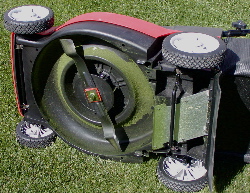The lawn mower has to be one of the most common garden machines in use. Just about every home in the UK owns one of these (or at least every home with a garden) and there are many different brands and designs available.
The first lawn mower was invented by Edwin Budding in 1827 in Thrupp, just outside Stroud in Gloucestershire. Budding’s mower was designed primarily to cut the grass on sports grounds and extensive gardens, as a superior alternative to the scythe, and was granted a British patent on August 31, 1830.
One of the very earliest surviving Lawn Mowers. From around 1832.
Budding’s first machine was 19 inches (480 mm) wide with a frame made of wrought iron. The mower was pushed from behind. Cast iron gear wheels transmitted power from the rear roller to the cutting cylinder, allowing the rear roller to drive the knives on the cutting cylinder; the ratio was 16:1. Another roller placed between the cutting cylinder and the main or land roller could be raised or lowered to alter the height of cut. Once cut, the grass clippings were hurled forward into a tray-like box. It was soon realized, however, that an extra handle was needed in front to help pull the machine along. Overall, these machines were remarkably similar to modern mowers.
There are three main types of mower available today. Cylinder, rotary and hover.
The cylinder mower carries a fixed, horizontal cutting blade at the desired height of cut. Over this is a fast-spinning reel of blades which force the grass past the cutting bar. Each blade in the blade cylinder forms a helix around the reel axis, and the set of spinning blades describes a cylinder.

A typical modern Cylinder Mower.
Of all the mowers, a properly adjusted cylinder mower makes the cleanest cut of the grass, and this allows the grass to heal more quickly. The cut of a well-adjusted cylinder mower is straight and definite, as if cut with a pair of scissors.
A rotary mower rotates about a vertical axis with the blade spinning at high speed relying on impact to cut the grass. This tends to result in a rougher cut and bruises and shreds the grass leaf resulting in discolouration of the leaf ends as the shredded portion dies. This is particularly prevalent if the blades become clogged or blunt.

Underside of a modern Rotary Mower
Most rotary mowers need to be set a little higher than cylinder equivalents to avoid scalping and gouging ofslightly uneven lawns, although some modern rotaries are fitted with a rear roller to provide a more formal striped cut. These machines will also tend to cut lower (13mm) than a standard four-wheeled rotary.
Hover mowers are powered rotary push lawn mowers that use an impeller above the spinning blades to drive air downwards, thereby creating an air cushion that lifts the mower above the ground. The operator can then easily move the mower as it floats over the grass. Hover mowers are necessarily light in order to achieve the air cushion and typically have plastic bodies with an electric motor. The most significant downside, however, is the cumbersome usability in rough terrain or on the edges of lawns, as the lifting air-cushion is destroyed by wide gaps between the chassis and the ground. Hover mowers are built to operate on steep slopes, waterfronts, and high-weeded areas, so they are often used by golf courses and commercial landscapers. Grass collection is often available, but can be poor in some models. The quality of cut can be inferior if the grass is pushed away from the blade by the cushion of air.

Hover Mower underside.

